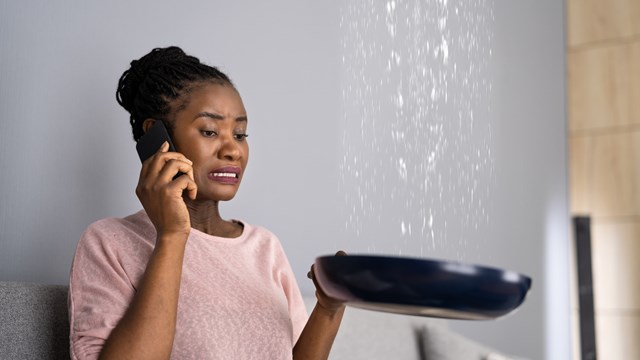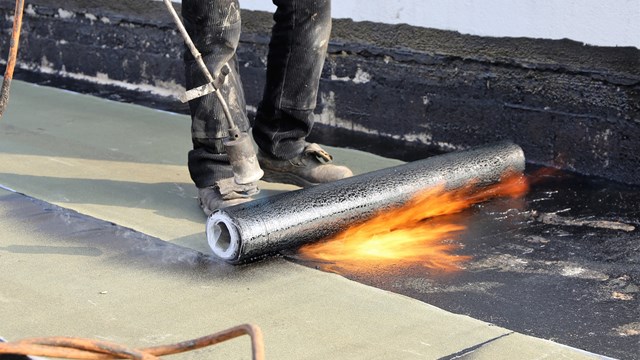A residential building’s roof is its first line of defense against whatever the skies throw at it. Left untreated, roof problems can proliferate and cause thousands of dollars in damages to residents’ property, as well as the building itself. When it comes to the literal roof over your head, “out-of-sight, out-of-mind” is definitely not the attitude to take—particularly once winter's bad weather has passed and left potential damage in its wake.
What's Up There?
In New York City, most residential roofs are flat roofs, which generally have little to no slope. Flat roofs represent the most efficient use of urban space, offer architectural freedom and energy savings, and control of the downflow of water into the drainage system. They are considered an economical alternative to the sloped roofs found on other residential structures, and are designed to protect the building from moisture and other exterior elements, and to support the mechanical and electrical equipment that serves the building.
Early flat roofs were designed using tar as a waterproof coating, but the uneven surface often created problems with rainwater and snow-melt ponding in low spots and causing leaks and other damage. Modern flat roofs use a continuous membrane covering which can better resist pools of standing water. These membranes are applied as a continuous sheet by utilizing sealants and adhesives that allow for bonding multiple sheets and dealing with structures—pipes, skylights, exhaust vents, and so forth—that penetrate the roof surface and can become entry points for water.
Roofing is pretty simple, says Wayne Bellet of Manhattan-based Bellet Construction Co. The roof consists of a membrane, into which are placed protrusions like pipes, parapets and drain openings. Roofs are vulnerable, he says, because they are exposed 365 days a year to weather—sunlight and ultraviolet rays, and most of all, moisture.
“There is one more ingredient that threatens the solvency of a roof, that being foot traffic. And foot traffic can be intentional vandalism, like people trying to deliberately harm the roof and then you have what I call accidental vandalism, which is, for example, women who wear their stiletto high heels that don't realize they are causing harm to the roof. People don't realize when they bring their terrace chairs and tables that when they sit on them, they're transferring 200 pounds of pressure into a softened asphaltic material that could cause a leak.”
Drains need to flow freely and if they are clogged or blocked by debris, snow or ice, leaks can form, he says.
As far as roofing technology has come in the last several decades, “Many property owners may not realize that the flat roofs that sit on top of their buildings actually need quite a bit of attention and care to keep it free from debris and leaks,” says Matt Riedel, owner of Riedel Roofing in Manhattan. “Over a period of time rain, wind and erosion will destroy any roof waterproofing.”
That’s why conscientious maintenance and seasonal upkeep are crucial for keeping roof structures sound and functional.
“You can’t inspect a roof surface when there is snow on it, so springtime is the best time to hire an inspector to look,” Riedel says. “The most vulnerable points of a flat roof are the seams. A lot of roofs are EPDM rubber, and the seams eventually start to degrade and peel open because of the constant sunlight.”
According to Joshua J. Attanasio, senior project manager for Centimark Corporation, all counter-flashing, metal work, equipment curb and supports, pitch-pockets, caulking, grease guards, traps, and any other rooftop accessories functioning in conjunction with the roofing system need to be inspected in order to stay functional.
“Cracking and splitting of the asphalt roof systems are the most common types of post-winter damage affecting New York City roofs,” says Attanasio. “You need to be concerned with penetrations, seams, flashings, terminations and masonry.”
Inspection Time
Thanks to the harsh winters that have hit the tri-state area over the last few years, many roofs have experienced increased problems due to the heavy snow and ice.
“If any cracks or abrasions have formed in your roof, when water seeps into them and subsequently freezes, it will expand and cause those cracks or abrasions to grow,” Attanasio says. “Preventing serious damage from snow and ice can be as simple as patching areas of your roof that appear to be worn with a durable sealant.”
Bellet agrees. “The freeze-thaw cycle that the winter poses is the biggest challenge. If you have an area of the roof that retains water for one reason or another, you'll have a lot of forces that turn into slush and snow and ice that will affect the membrane that's beneath it. I would just visually check the roofing membrane,” and associated roof components, he says.
Preventative maintenance is far more cost effective than full-scale repairs, which is why one should always hire a professional to inspect and look for problems as soon as the weather starts to warm up.
“Sometimes the roofs are older and are cracked in the first place and the ice tends to work on the membranes and cracks them further,” Riedel says. “A lot of times the walls will have flashings ripped off due to the heavy winter wind, or the roofing systems going up the wall will crack.”
Attanasio recommends having your roof inspected at minimum two times a year, and while your building super can and should make periodic checks of the roof for obvious damage, these in-depth, twice-yearly examinations should always be done by a professional.
“Inspectors look for anything and everything that can be problematic,” he says. “Our company provides free roof evaluations, which includes investigation of masonry concerns. Every project is different—if we are doing Local Law 11 inspections for example, the fee range depends on a number of logistical concerns.”
While some building managers may be surprised that Local Law 11 factors into all this, Attanasio explains that it’s not always necessary and only matters in extreme circumstances. “Local Law 11 relates to potential fall hazards from the masonry on the exterior. It typically does not relate to concerns of the roof unless degraded internal parapet walls start affecting the masonry on the exterior,” he says. “This may lead to rebuilding the wall, which would certainly affect the roof area.”
Ponding Problems
One of the more serious problems that one can encounter on the roof involves ponding, which is water standing on the roof for more than 48 hours.
“The ponds soak into the membrane and ruin it,” Riedel says. “From there, it will soak into the insulation under the roofing system and ruin that, and from there, it can get into plywood decking and rot that too.”
Because they lack pitch, flat roofs don’t really shed water naturally. They need the gutters and drains in order to get the water off, and if the gutters and drains get clogged, then water will accumulate on the roof and cause problems. Moisture damage in your roof is cumulative and the longer moisture is allowed to collect or seep through your roof, the more damage it does and the more expensive repairs will be. That's why it's so vital that building roofs remain free and clear of debris.
If residents are leaving bottles or other garbage on the roof, it's only a matter of time before a bit of debris obstructs a gutter or drain, causing water to back up and leak into the building. If residents are allowed onto the roof at all, water exit-points must be kept clear, and both residents and building staff must be vigilant in enforcing that.
On Top of Things
Most roofing companies charge in the neighborhood of $75 to $150 per hour to inspect a New York City co-op or condo roof—which is a bargain compared to the cost of damage an overlooked roof ailment can cause.
The nominal cost also highlights the importance of having a professional inspection, rather than relying on the building super or handyman to make a thorough, accurate assessment. “A lot of these buildings will send a handyman up to look, and they don’t know anything about roofing,” says Riedel. “Their only weapon is a bucket of cement, and they can screw more things up than they can fix. Would you go to me to fix your teeth if I just put up a shingle and said I was a dentist? Of course not.
Riedel has seen numerous cases of people trying to fix problems by plopping a coat of tar over the cracks and splits in their roof membrane, and while this may seem to work as a temporary solution, in 3 to 6 months, the tar will peel and the problem will still be there—and may in fact be worse.
“We can do infrared scans for moisture, and there are other things that a professional can look at and understand that people who aren't qualified just can’t,” Riedel says. “We are looking for buckling, cracking, peeling, holes, flashings that are off the building, tar that is breaking open. You also have to look for debris up on the roof and drains clogging things.”
Green Roofs
If your building has a so-called 'green' roof—one planted with vegetation designed to absorb rainfall and improve energy efficiency—there aren’t as many issues that come into play when springtime comes around. Maintenance concerns for green roofs include replacing any plants that may have died over the winter and just checking for debris and some of the same concerns of a normal roof.
“There is very little maintenance needed as long as the green roof is installed correctly in the first place,” Riedel says, “because the green roofing protects the membrane underneath. They do need to be professionally built; you don’t want to just throw on a roof and put some dirt and stuff on top of it.” Overloading, improper drainage, damage caused by tools, foot traffic, and plant roots are all considerations that a professional will take into account when designing and installing a green roof project.
Final Thoughts
Roof neglect is a big problem in residential buildings, but not taking proper care of them can result in some serious problems down the road.
“People need to be mindful of their surroundings and not take for granted that the roof can be damaged if handled improperly,” Attanasio says.”Hire a professional and stop any problems before they happen.”
Keith Loria is a freelance writer and reporter and frequent contributor to The Cooperator.










Leave a Comment